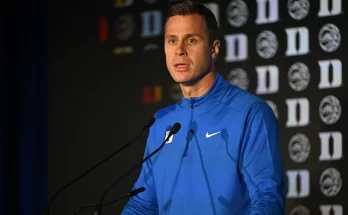The Boston Celtics remain locked in a complex balancing act this offseason, with Anfernee Simons emerging as a key figure in their evolving roster strategy. Despite acquiring Simons in a recent trade, reports suggest the Celtics are still actively exploring options to move him again. It’s a curious but strategic move that stems from both on-court concerns and off-court financial considerations. Simons is a dynamic scoring guard with considerable upside, but his fit in Boston’s system and the team’s financial position could make him a short-term guest rather than a long-term fixture.
Simons was brought in as part of the Celtics’ contingency plan after missing out on Damian Lillard, who ultimately stayed put rather than forcing a trade to a contender. Boston had been linked to Lillard in rumors for months, hoping to add another top-tier scorer to pair with Jayson Tatum and Jaylen Brown. Once those efforts fell short, the front office pivoted and acquired Simons, who had spent his entire career with the Portland Trail Blazers. At first glance, the trade seemed like a smart move. Simons is a proven offensive talent who can score in bunches, create his own shot, and stretch the floor with his range. But as the dust settled, it became clear the Celtics were not fully committed to him as part of their future core.
One of the main reasons Boston is still exploring trade options involving Simons is financial. The Celtics are deep into luxury tax territory and are approaching the dreaded second apron, a threshold in the NBA’s new collective bargaining agreement that imposes significant penalties on teams with high payrolls. These penalties aren’t just monetary—they also limit roster flexibility, preventing teams from signing players on the buyout market or aggregating salaries in trades. For a team like Boston, which already carries several max or near-max contracts, every dollar counts. Simons is on an expiring contract worth nearly \$28 million. If the Celtics don’t plan to re-sign him, it makes more sense to flip him now for assets or players who better fit their needs and budget.
From a basketball standpoint, Simons is a mixed bag for the Celtics. Offensively, he brings a lot to the table. He averaged just under 20 points per game last season and shot nearly 38 percent from three-point range. He’s particularly dangerous in pick-and-roll situations and has improved as a playmaker. In Portland, he stepped up when Damian Lillard was out, proving he could be a lead guard in stretches. His scoring instincts and shooting mechanics make him a valuable offensive weapon, especially for a Boston team that sometimes struggles with bench production and late-game shot creation.
However, his defensive limitations are a concern. Simons is undersized for a two-guard at around 6’3″, and his lack of physicality and awareness has made him a frequent target on the defensive end. Boston’s identity under head coach Joe Mazzulla has been rooted in defensive intensity and versatility. Players like Derrick White, Jrue Holiday, and Marcus Smart (before he was traded) set a high bar defensively. Simons doesn’t meet that standard, and it’s unclear whether he can improve enough on that end to become a reliable two-way contributor. In a playoff setting, when matchups are constantly exploited, his defensive weaknesses could become a liability.
The uncertainty surrounding Simons is also amplified by Boston’s current roster structure. The team is in a bit of a transitional phase. Kristaps Porziņģis is gone. Jrue Holiday, who was key in last year’s Finals run, has been dealt. Al Horford is nearing the end of his career, and Jayson Tatum is dealing with a long-term Achilles injury that may sideline him for much of the upcoming season. That leaves Jaylen Brown and Derrick White as the primary leaders, with a need for both stability and star power around them. Simons can help on the scoring front, but he doesn’t bring the leadership or playoff experience the Celtics might need in a locker room already losing key voices.
Another factor in the Celtics’ decision-making is Simons’ market value. At 27, he’s still young enough to appeal to rebuilding teams and good enough to contribute right away for contenders. His expiring contract makes him especially attractive to teams looking for short-term help without long-term financial commitments. There are several teams reportedly interested in acquiring him, including those in need of scoring depth or a starting-caliber guard who can create off the dribble. Boston is reportedly fielding offers that include draft picks, rotational players, or frontcourt help in return. It’s not just about moving Simons to save money—it’s also about filling holes in the roster and positioning the team for success in both the short and long term.
If Boston does choose to trade Simons, it could go in a few directions. They could target a veteran forward or center who brings physicality and experience, something they currently lack with their thin frontcourt. They might look for a wing defender to complement Brown and White, especially given the uncertainty around Tatum’s availability. Alternatively, they could pursue a package of younger players and draft picks, betting on long-term development while keeping financial flexibility intact. Each path has pros and cons, but all depend on how the front office evaluates Simons’ long-term value to the team.
Of course, there’s also the possibility that Simons stays. If Boston can’t find a suitable trade or if they decide to roll the dice on his potential, he could remain with the team through the season. In that scenario, Simons could play a vital role, especially early on while Tatum is out. His ability to generate offense could take pressure off Brown and White and give Boston a more balanced scoring attack. If he thrives in that role and shows improvement on defense, the Celtics might reconsider their stance and explore re-signing him next summer. But that would likely require a significant financial commitment, one that the team may not be willing or able to make given their existing salary obligations.
The Simons situation highlights a broader trend in the NBA: the growing influence of the salary cap and luxury tax rules on roster decisions. In the past, teams could simply hold onto talent and deal with the financial implications later. Now, with the new CBA creating harsher penalties for teams that exceed the tax thresholds, even top contenders like Boston have to think strategically about every move. The decision to keep or trade Simons isn’t just about wins and losses—it’s about managing the books, maintaining flexibility, and avoiding punitive restrictions that could hamper future moves.
In many ways, Simons has become a symbol of Boston’s current crossroads. He’s talented enough to contribute, expensive enough to raise concerns, and young enough to draw interest around the league. Whether the Celtics keep him or move him will say a lot about their priorities heading into the new season. Are they still all-in on contending now, even with Tatum’s injury? Or are they taking a more cautious, long-term approach that values flexibility over short-term firepower?
There’s no easy answer. The Celtics are navigating a tight window of opportunity, with a championship-caliber core that’s now under pressure to adjust without their best player. Every move they make this summer must serve multiple purposes—improving the roster, managing the cap, and preparing for the unknown. Anfernee Simons fits into that equation as both an asset and a question mark. How they handle his situation may ultimately shape the narrative of their offseason.
As training camp approaches and teams begin to finalize their rosters, Boston’s intentions with Simons will likely become clearer. For now, the reports that they are still actively exploring trade options indicate that his arrival was never intended to be the final step. Instead, it was another move in a longer game, one where financial prudence and competitive ambition must coexist. Whether Simons remains part of the Celtics’ journey or is sent elsewhere, one thing is clear: Boston’s front office isn’t done yet.
—
Let me know if you’d like a shorter version or if you’d like the same article in a different tone.



